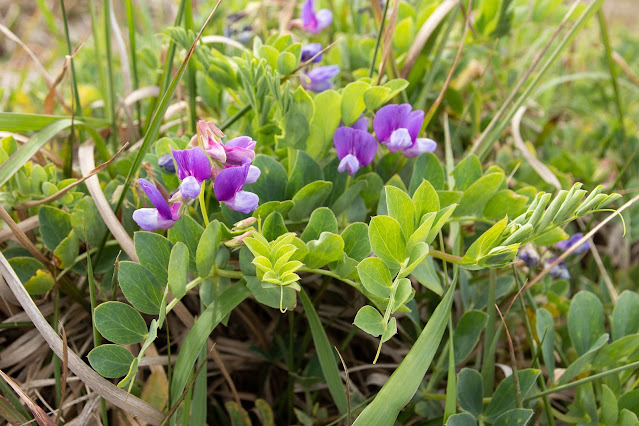In the spring, beach peas emerge in salt marshes and along the Connecticut shoreline. Walking along the coastline, look for them amid driftwood, dunes, or mixed in with seagrass. This strictly maritime plant has a long and interesting culinary and medicinal history.
About Beach Pea
Beach Peas or Lathyrus japonicus are trailing herbaceous perennial vines, usually no taller than 18 inches that grow in sandy soil in patches. The hairless compound leaves grow in three to five pairs of ovate waxy leaflets that are smooth and light green to bluish green on the surface and whitish green on their underside. The terminal leaflet is replaced by a twining tendril. The flowers grow on a long hairless stem in loose clusters of up to twelve showy pink or purple flowers. The fruits lend this plant its name because they look like small dark pea-pods. Because the seeds can stay viable in water for up to five years, this plant has spread throughout much of the world on ocean waves. Germination occurs when the outer seed husk is abraded by waves on the sand. It flowers in July and August in the Northern Hemisphere and in January and February in the Southern Hemisphere.
Uses of Beach Pea
There is not much documentation on the medicinal uses of the beach pea plant. It has been recorded that the Iroquois cooked the stalks and used this liquid to treat rheumatism. The Ojibwa used this plant to treat stomach trouble. The Eskimos roasted seeds and used them to make coffee.
The Ojibwa fed a pony or horse that they were about to race the leaves and roots to put spirit into the animal. The plant was also fed to a sick pony or horse to make him or her fat. The Meskwaki used the root as bait to trap a beaver or other game animals.
One of the most common uses by Native American communities was to eat the young stalks in the spring and to eat the immature seeds as peas. Although the pods can be eaten, like many members of this genus, Lathyrus, they contain an acid that can cause paralysis called lathyrism.
Did You Know...
The seed of this plant contains a toxic amino acid which in large quantities can cause, lathyrism, a disease of the nervous system.
Lathyrus is from the Greek word thouros meaning "something exciting" from the belief that the seed had medicinal value.
Another name for this plant is circumpolar pea or sea vetchling.
The peas are eaten by deer, mice, and birds. The flowers are a source of food for bees and butterflies.
The leaves of this plant are used in Chinese medicine.


.JPG)
No comments:
Post a Comment